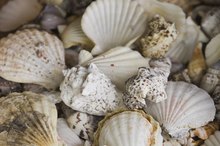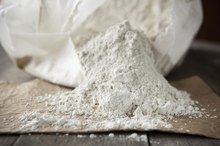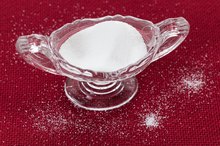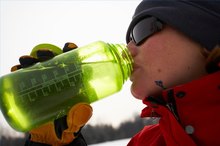The nutrients found in seawater are essential to the survival of plant and marine life. Typical seawater has a salinity—salts dissolved in the water--of approximately 35 parts per thousand, according to MarineBio.net. There are many different types of gases, nutrients and other substances found in seawater, and they all get there either from the Earth’s crust, sea floor or through the waste and decaying of dead plants and animals. When seawater is used for medical purposes, it is called thalassotherapy.
Nitrogen
Essential for the growth of sea plants, nitrogen is an important part of the ocean ecosystem. Nitrogen is released into seawater when dead plants begin decomposing, and the feces of marine life directly contribute to the levels of nitrogen in seawater. Nitrogen is also an essential nutrient for humans, making up approximately 3 percent of the human body, according to LiveScience.com 2.
Phosphorus
Calcium Carbonate and Seashells
Learn More
Much like nitrogen, phosphorous is a dissolved nutrient found in seawater that is important for plant growth. Because most dead plant and marine fecal matter falls to the bottom of the ocean, the greatest concentrations of phosphorous can be found near the sea bed, according to MarineBio.net. Phosphorous is found in human bones and helps keep them strong.
Potassium
Potassium is another dissolved nutrient that aids in healthy plant growth. It is found in the highest concentrations near the sedimentary bottom of the sea bed. This nutrient is vital to the human body, as it helps regulate your heart beat.
Sulfur
Diatomaceous Earth Nutrition
Learn More
The majority of sulfur on Earth is found in seawater or sedimentary rocks that may have previously been, or still are, under water. Sulfur in seawater occurs mainly in the form of sulfate or sodium chloride, according to SeaFriends.org 1. This seawater nutrient helps proteins in the human body take shape, so it's an important element of thalassotherapy.
Magnesium
Magnesium is the third most abundant ion found in seawater, according to AdvancedAquarist.com. It is typically found in seawater at levels reaching higher than 1,200 parts per million, or ppm. Magnesium plays a big part in reef ecosystems in terms of the calcification of numerous types of organisms. In other words, it takes the place of calcium in many cases. Magnesium also plays an important role in the human body because it plays an integral role in over 300 metabolic reactions in the body, according to LiveScience.com 2.
- Magnesium is the third most abundant ion found in seawater, according to AdvancedAquarist.com.
- Magnesium also plays an important role in the human body because it plays an integral role in over 300 metabolic reactions in the body, according to LiveScience.com 2.
Calcium
Calcium is a nutrient found in seawater that is required by many sea organisms. Calcium ions float freely for the most part, although they do occasionally bond with other ions, such as sulfate, carbonate and bicarbonate. Calcium is used in reef ecosystems to form calcium carbonate skeletons. These skeletons are essential for the survival of many marine creatures, such as crabs, lobsters, oysters and corals. Calcium is the most abundant mineral in the body, and it is an essential part of healthy bones and teeth. This nutrient, like most others contained in seawater, can be absorbed through the skin and into the bloodstream, which is basically how thalassotherapy works, according to Pureinsideandout.com 4.
- Calcium is a nutrient found in seawater that is required by many sea organisms.
- These skeletons are essential for the survival of many marine creatures, such as crabs, lobsters, oysters and corals.
Related Articles
References
Writer Bio
Joseph Eitel has written for a variety of respected online publications since 2006 including the Developer Shed Network and Huddle.net. He has dedicated his life to researching and writing about diet, nutrition and exercise. Eitel's health blog, PromoteHealth.info, has become an authority in the healthy-living niche. He graduated with honors from Kellogg Community College in 2010 with an Associate of Applied Science.








